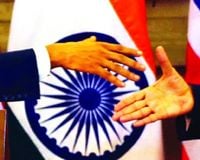India’s global trade landscape is undergoing a period of rapid transformation, marked by shifting alliances, bruising tariff battles, and diplomatic maneuvering that could reshape economic fortunes for years to come. Over the past several months, a dramatic escalation in U.S. tariffs has battered India’s export sector, while at the same time, new opportunities are emerging through deepening ties with Brazil and ongoing negotiations over Russian oil imports. The stakes are high for New Delhi, as it seeks to balance competing pressures from Washington, Moscow, and ambitious partners in the Global South.
According to BBC News, India’s goods exports to the United States—its largest foreign market—plunged by a staggering 20% in September 2025, following the full implementation of steep new tariffs by the Trump administration. The drop is even more pronounced over the last four months, with nearly 40% wiped from export volumes to the U.S. since May. The tariffs, which took effect on August 27, 2025, include a punitive 25% penalty for India’s continued purchases of Russian oil, on top of a sweeping 50% duty on most Indian goods. The result: four consecutive months of declining shipments, slashing exports from $8.8 billion in May to just $5.5 billion in September—a 37.5% fall.
Ajay Srivastava of the Delhi-based Global Trade Research Initiative (GTRI) told BBC News, “US has become India's most severely affected market since the tariff escalation began.” The impact has been especially severe in labor-intensive sectors such as textiles, gems and jewellery, engineering goods, and chemicals. For thousands of Indian workers and small businesses dependent on U.S. demand, the fallout has been swift and painful.
The trade shock has also widened India’s trade deficit to a 13-month high of $32.15 billion in September. While some of the lost ground has been cushioned by improved trade with countries like the UAE and China, the U.S. remains a critical partner. Until recently, the two countries boasted bilateral trade worth $190 billion in 2024, with ambitious goals set by President Trump and Prime Minister Narendra Modi to more than double that figure to $500 billion. But the path to that target now looks uncertain.
Efforts to break the deadlock resumed last month, with Indian negotiators traveling to Washington in hopes of clinching a deal by November. Major sticking points remain, including U.S. demands for greater access to India’s protected agriculture and dairy sectors—an area India fiercely defends, citing food security and the livelihoods of millions of small farmers. Nevertheless, both sides appear eager to avoid a prolonged standoff. An Indian foreign ministry spokesperson told BBC News that discussions were “ongoing” and that the U.S. had “shown interest in deepening energy co-operation with India.”
Yet, the tariff drama is only one part of a larger geopolitical chess game. A parallel story is unfolding around India’s oil imports from Russia—a critical flashpoint for Washington. The White House told Reuters on October 16, 2025, that India had halved its Russian oil imports, a move Washington sees as vital to choking off revenue to the Kremlin and pressuring President Putin to negotiate peace in Ukraine. However, Indian industry sources flatly denied any immediate cut, noting that refiners had already booked cargoes for November and December, and that data from Kpler actually showed imports set to rise 20% in October to 1.9 million barrels per day.
President Trump, never one to shy away from bold claims, asserted on October 15 that Prime Minister Modi had assured him India would stop buying oil from Russia. India’s foreign ministry, however, quickly denied any such conversation. The U.S. tariffs, in part, are designed to squeeze India’s energy trade with Russia, adding an extra layer of complexity to already fraught negotiations. Meanwhile, crude oil futures dipped 1% to $56.87 per barrel during the latest round of talks, reflecting market uncertainty over global supply dynamics.
As India navigates these choppy waters, it is also looking to broaden its horizons. On October 18, 2025, Brazilian President Luiz Inácio Lula da Silva announced plans to forge a “strategic alliance” with India, aimed at strengthening political, economic, and technological cooperation. In a video message posted on X, Lula emphasized, “We can have a fantastic alliance with India—political, space, entrepreneurial, and economic.” He added, “The Indians like Brazil, and Brazilians like Indians. Therefore, we will create a strategic alliance with India and develop both Brazilian and Indian economies.”
Lula’s announcement followed the visit of Brazilian Vice President Geraldo Alckmin to India earlier in October, which laid the groundwork for Lula’s planned state visit in early 2026. The focus: boosting business relations and fostering economic complementarity, rather than competition. As Alckmin told ANI, “Independent of the American question, we are talking about two countries, two democracies, two countries that defend multilateralism, two countries of continental dimensions, both Brazil and India, that have everything to make trade grow, to make more investments grow.” He stressed that both nations are “not going to compete on product; we are going to have economic complementarity.”
The fruits of this budding partnership are already visible. Brazilian aerospace giant Embraer is opening an office in India, an e-visa system is being implemented to ease business travel, and new partnerships are springing up. During the July 2025 Modi-Lula summit in Brazil, the two leaders set an ambitious target of lifting bilateral trade to $20 billion within five years—a significant leap from the $12.19 billion recorded in FY 2024-25, according to India’s Ministry of Commerce and Industry. Brazil has thus strengthened its position as India’s largest trading partner in Latin America and the Caribbean.
All this comes against the backdrop of the U.S. imposing similar 50% tariffs on several Brazilian goods in August 2025, further encouraging both India and Brazil to diversify their trade partners and reduce reliance on American markets. Alckmin was quick to clarify, however, that these moves are not about forming an anti-U.S. bloc, but rather about seizing new opportunities. “There is a lot of possibility for complementarity: in the area of technology, industrial area, mining, agro,” he told ANI, pointing to Brazil’s record agricultural harvest and India’s rapid economic growth as areas ripe for collaboration.
For India, the coming months will be a test of diplomatic agility. The country must weigh the costs of U.S. tariffs against the benefits of cheap Russian oil and the promise of new alliances. Trade negotiations with Washington continue, even as Indian refiners keep their options open with Russian suppliers. Meanwhile, the strategic embrace with Brazil signals a broader shift toward a more multipolar, resilient trade strategy—one less beholden to the whims of any single power.
The world is watching as India charts its course. The choices made in New Delhi, Washington, and Brasilia will ripple far beyond their borders, shaping the contours of global commerce and diplomacy in a time of profound uncertainty.





